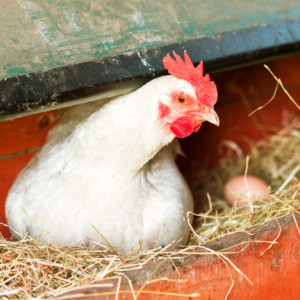 How to Switch to a Chicken Layer Feed: Switch laying hens to a complete chicken layer feed when they start laying eggs around 18 weeks of age. Choose a complete layer feed that includes all the essential nutrients laying hens need to lay strong and stay strong. Then make the transition gradually over one week.
How to Switch to a Chicken Layer Feed: Switch laying hens to a complete chicken layer feed when they start laying eggs around 18 weeks of age. Choose a complete layer feed that includes all the essential nutrients laying hens need to lay strong and stay strong. Then make the transition gradually over one week.
When you turn 18, you can do a lot of new things. You can vote, buy fireworks and even try your luck with the lottery. The magical number means welcome to adulthood.
For backyard chickens, the number 18 means the same thing. Eighteen weeks is the age when laying hens are considered adults. Most excitingly, it’s the time when many chicken breeds will start laying eggs. At this key milestone, switch your hens to a complete layer feed.
This feed switch is an essential step down the road to farm fresh eggs because hens require different nutrients to produce eggs as compared to when they are growing.
To produce an egg each day, hens need high levels of calcium, vitamins and minerals. Hens transfer many of these nutrients directly into their eggs, so the nutrients in layer feed play an essential role in egg production.
Consider the following steps when transitioning to a complete chicken layer feed:
1. Choose a chicken layer feed that matches your goals.
 The best chicken feed for layers depends on your flock goals. Select a complete layer feed before the transition begins. Ideally, make your layer feed decision by week 16, so you’re ready to make the transition at week 18.
The best chicken feed for layers depends on your flock goals. Select a complete layer feed before the transition begins. Ideally, make your layer feed decision by week 16, so you’re ready to make the transition at week 18.
First, look for a complete layer feed. This means the feed should be formulated to provide all the nutrients laying hens require without a need to supplement. Choose a layer feed with the Purina® Oyster Strong® System to help your hens lay strong and stay strong.
Which layer feed Oyster Strong® System is right for your flock?
- Purina® Layena® pellets or crumbles Our most popular layer feeds
- Purina® Layena® Omega-3 Includes added omega-3 fatty acids for your health
- Purina® Layena® Free Range Includes insect protein
- Purina® Organic Layer Feed Certified USDA Organic
Each of these chicken layer feeds is made with simple, wholesome ingredients, 16 percent protein, at least 3.25 percent calcium as well as key vitamins and minerals. They also include our exclusive Oyster Strong® System to ensure your laying hens achieve a balanced supply of calcium through a blend of oyster shell, vitamin D and manganese. These three ingredients work together to help your chickens produce strong-shelled, delicious eggs each day.
These are just the essentials, though. Additional ingredients in Purina® complete layer feeds help bring hen health and egg quality to the next level.
A few next-level ingredients to look for include:
- For rich, yellow yolks: Marigold extract
- For strong shells and healthy hens: Oyster Strong® System
- For immune and digestive health: Prebiotics and probiotics
- For vibrant feathering: Essential amino acids such as lysine and methionine
- For omega-rich eggs: Added omega-3 fatty acids
2. Transition to chicken layer feed over one week.
When birds reach 18 weeks old or when the first egg arrives, gradually switch your laying hens to a complete layer feed. It’s important to make the transition over time to prevent digestive upset.
On our farm in Missouri, we’ve found it’s best to make chicken feed transitions over time rather than all at once. We mix the starter-grower feed and layer feed evenly for four or five days. If birds are used to crumbles, start with a crumble layer feed. The same goes with pellets. The more similar the two chicken feeds are, the more smoothly the transition will go.
Many hens will eat the mixed feed without noticing a difference. When laying hens are eating both feeds, you can stop feeding the starter-grower feed and make the complete switch to all layer feed. It is important to give your birds enough time to adjust to the new diet. Most birds will adjust within a couple days but some can take a couple weeks to fully transition to their new diet.
3. Keep chicken feed consistent.
Once the transition to layer feed is complete, it’s best to maintain a routine.
We recommend providing free choice layer feed to hens and switching out the feed each morning and evening. Laying hens eat approximately 0.25 pounds of complete feed each day, equaling about one-half cup.
If birds are free-ranging, offer complete layer feed before they go out in the morning. This will help them consume the essential nutrients before filling up on less nutritionally balanced insects and plants.
It’s important for the complete feed to make up at least 90 percent of the hen’s diet. We feed complete layer feeds on our farm because they are formulated to provide all the nutrients hens require at the correct levels. It’s reassuring to know that each bite of feed is balanced to keep our hens healthy and producing quality eggs.
North Fulton Feed can help you to Switch to a Chicken Layer Feed. Visit us! We are open Monday – Friday: 8 a.m. to 6 p.m. and Saturday: 8 a.m. to 5 p.m. You can also contact us by phone at (770) 475-5572.
Article Source: Purina Mills
